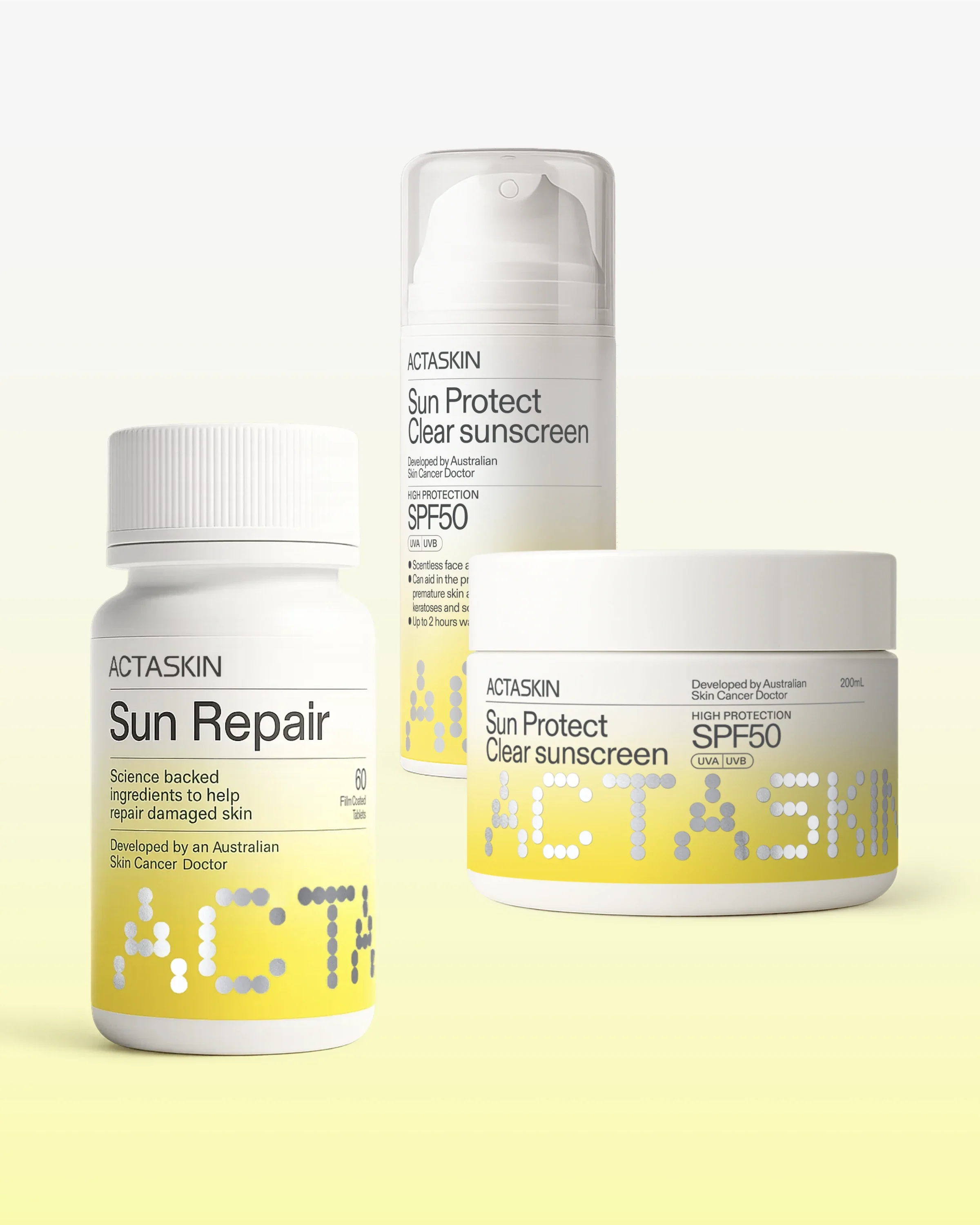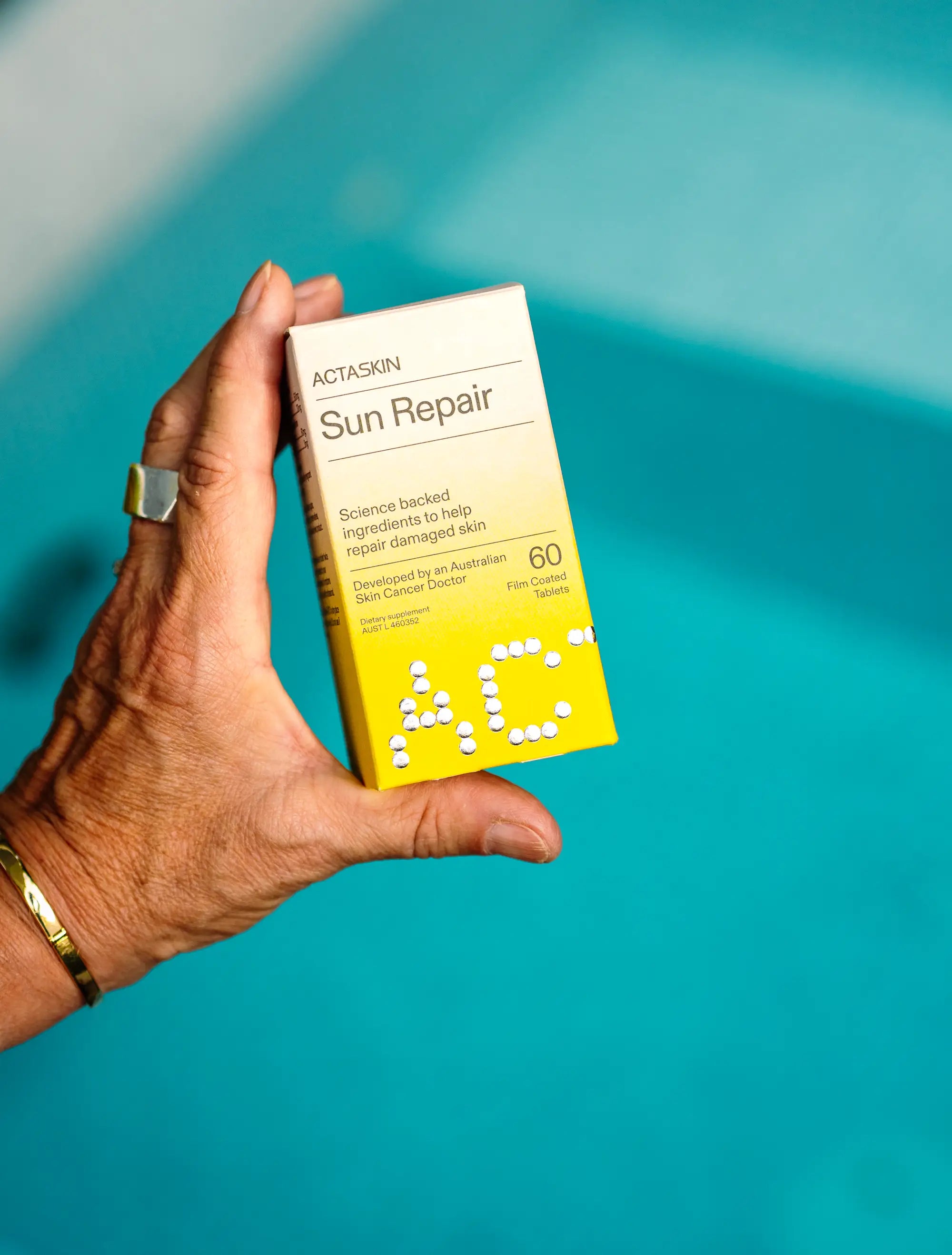New Study: Nicotinamide Supplement Can Cut Skin Cancer Risk by 50% After First Diagnosis
By Dr Austin Lang | Master of Medicine (Skin Cancer), Bachelor of Surgery, Bachelor of Medicine, Bachelor of Science, FRACGP
Chief Medical Officer, Actaskin
At Actaskin, we’ve always believed prevention and repair go hand in hand. The latest clinical evidence confirms it: Nicotinamide: the hero ingredient in our Sun Repair supplement – can significantly reduce the risk of skin cancer recurrence.
The Latest Research on Nicotinamide and Skin Cancer Prevention
In September 2025, JAMA Dermatology published the largest real-world study of Nicotinamide for skin cancer prevention. Researchers analysed 33,822 U.S. veterans with a history of non-melanoma skin cancers (basal cell carcinoma and squamous cell carcinoma), tracking outcomes through Veterans Affairs health records.
Key findings:
-
After the first skin cancer diagnosis: Starting nicotinamide early reduced the risk of another skin cancer by 50–54%.
-
Overall benefit: Nicotinamide lowered the overall rate of new skin cancers by 14% (HR 0.86; 95% CI, 0.82–0.89).
-
By cancer type: The greatest impact was on cutaneous squamous cell carcinoma (cSCC), with a 22% risk reduction. Basal cell carcinoma (BCC) benefits were most pronounced when nicotinamide was started after the first cancer.
-
Timing matters: Patients who began nicotinamide after multiple cancers saw less benefit – reinforcing the importance of starting early.
-
High-risk groups: Solid organ transplant recipients didn’t see broad benefit, but those who began nicotinamide after one or two cancers still reduced their risk of cSCC.
👉 Read the full JAMA Dermatology article here.
How This Builds on the ONTRAC Trial
This study echoes the landmark ONTRAC trial (2015) conducted in Australia, a randomised controlled trial (RCT) that first demonstrated nicotinamide’s preventive power.
-
23% reduction in all new non-melanoma skin cancers
-
20% reduction in basal cell carcinoma (BCC)
-
30% reduction in squamous cell carcinoma (SCC)
The new U.S. veteran data validates ONTRAC’s findings in a large, real-world population – proving that nicotinamide works beyond the clinical setting.
The takeaway: nicotinamide is most effective when started early, especially after the first skin cancer.
Why Actaskin Sun Repair is Different
While Nicotinamide is the foundation, Sun Repair goes further by combining three evidence-based ingredients to address both skin cancer risk and visible sun damage:
-
Nicotinamide (Vitamin B3) – clinically proven to reduce the risk of non-melanoma skin cancers and support DNA repair.
-
Astaxanthin – a potent antioxidant shown to calm redness, reduce oxidative stress, and even skin tone.
-
Sodium Hyaluronate – a deeply hydrating molecule that restores barrier strength, plumps skin, and smooths fine lines.
This multi-layered approach means you’re not just protecting your skin’s future, but also repairing, hydrating, and strengthening your skin every day.
The Bottom Line
The evidence is stronger than ever:
-
ONTRAC trial (2015): 20–30% reduction in non-melanoma skin cancers.
-
JAMA Dermatology study (2025): Up to 54% reduction in recurrence when Nicotinamide is started after the first skin cancer.
Daily nicotinamide is one of the most powerful, evidence-based tools we have for skin cancer prevention and repair of sun damage.
With Actaskin Sun Repair, you get nicotinamide plus added antioxidants and hydration – a complete daily supplement designed by a skin cancer doctor to support healthier, stronger skin.
Frequently Asked Questions About Nicotinamide and Skin Cancer
Does Nicotinamide prevent skin cancer?
Yes. Multiple studies, including the landmark ONTRAC trial in Australia and a large 2025 JAMA Dermatology study of over 33,000 U.S. veterans, show that daily high-dose nicotinamide can reduce the risk of new non-melanoma skin cancers. The protective effect is strongest when started after the first skin cancer diagnosis.
How much Nicotinamide should I take for skin cancer prevention?
In clinical studies, the effective dose was 500 mg twice daily. This is the same dose used in Actaskin’s Sun Repair supplement, developed by an Australian skin cancer doctor.
What types of skin cancer does nicotinamide reduce?
Research shows nicotinamide reduces the risk of basal cell carcinoma (BCC) and squamous cell carcinoma (SCC) — the two most common non-melanoma skin cancers. It does not replace sunscreen or other sun protection measures.
Is nicotinamide safe for long-term use?
Yes. Nicotinamide has been shown to be safe in long-term use at the studied dose, with minimal side effects compared to other skin cancer prevention medications. It is well tolerated and does not cause flushing like niacin (nicotinic acid).
What is the ONTRAC trial?
The ONTRAC trial was a 2015 randomised controlled trial in Australia. It showed that nicotinamide reduced new skin cancers by 23% overall, including 20% for BCC and 30% for SCC, in high-risk patients.
How is Sun Repair different from taking nicotinamide alone?
Actaskin’s Sun Repair combines clinical-strength nicotinamide with astaxanthin (a powerful antioxidant) and sodium hyaluronate (a deep skin hydrator). This unique formula not only supports DNA repair and cancer prevention but also improves hydration, redness, and skin barrier resilience.
Dr Austin Lang is a skin cancer doctor renowned for his expertise in diagnosis and management, with a strong focus on prevention and patient-centered care. He leads Actaskin’s clinical strategy and product development.
References
Breglio, K. F., Knox, K. M., Hwang, J., Weiss, R., Maas, K., Zhang, S., Yao, L., Madden, C., Xu, Y., Hartman, R. I., & Wheless, L. (2025). Nicotinamide for skin cancer chemoprevention. JAMA Dermatology. Advance online publication. https://doi.org/10.1001/jamadermatol.2025.XXXX
Chen, A. C., Martin, A. J., Choy, B., Fernández-Peñas, P., Dalziell, R. A., McKenzie, C. A., Scolyer, R. A., Dhillon, H. M., Vardy, J. L., Kricker, A., St George, G., Chinniah, N., Halliday, G. M., & Damian, D. L. (2015). A Phase 3 Randomized Trial of Nicotinamide for Skin-Cancer Chemoprevention. The New England journal of medicine, 373(17), 1618–1626.



